 Leading Blog | Posts by Month |
 Leading Blog | Posts by Month |
04.30.18

LeadershipNow 140: April 2018 Compilation
See more on
Posted by Michael McKinney at 07:18 AM
04.23.18

The Excellence Dividend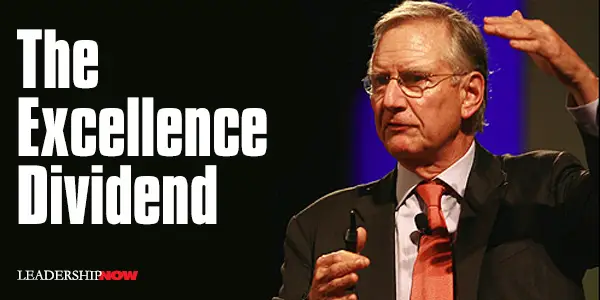
T We are faced with a tech tsunami that threatens our work. Daniel Huttenlocher, dean of Cornell Tech, said, “The industrial revolution was about augmenting and replacing physical labor, and the digital revolution has been about augmenting and replacing mental labor.” Machine learning and Artificial intelligence will change the way we work. Peters says that the best defense against this tech tsunami is excellence. Excellence is an offensive strategy. It's proactive. We need to focus “on the human attributes that will, effectively deployed, likely remain beyond the realm of artificial intelligence.” He believes we need to go on the offensive creating excellence in everything we do. Excellence is not a list of dos and don’ts. It’s really a quality of heart. It’s a “state of mind.” It’s expressed in everything we do—the next thing we do. It’s our next e-mail; our next conversation. “Excellence is a moment-to-moment way of life. Or it is nothing at all. There’s no tomorrow in excellence; there is only right now.” “Excellence is the next five minutes.” Little touches are the most important differentiators. Little is greater than big. Execution, then is everything. Execution is the leader's job. “Amateurs talk about strategy. Professionals talk about logistics,” said General Omar Bradley. “Get moving now. Get the job done. On this score, nothing has changed in 50 years, including the fact that all too often the strategy is inspiring, but the execution is largely AWOL.” People first. Hard is soft. Soft is hard. “Your customers will never be happier than your employees.” Training is your most important investment. “Simply put,” says Peters, “helping your employees achieve a worthwhile future turns out to be the most profitable way to run a company. Period.” When it comes to innovation WTTMSW: Whoever Tries The Most Stuff Wins and it’s corollary, WTTMSASTMSUTFW: Whoever Tries the Most Stuff And Screws The Most Stuff Up The Fastest Wins. It’s a numbers game. “If you know where you’re heading, you’re not innovating. If things work out as planned, you weren’t chasing anything interesting.” We must become fully immersed to innovate. “To deal effectively and creatively with a given context, we must push ourselves hard, very hard, systematically, one day at a time, one hour at a time, to become fully engaged with novelty. Novel settings. Novel people. Novel everything.” When it comes to leaders, “the best of the best are extraordinary listeners.” Most of us think we are good listeners, but we aren’t. “Listening is strategy.” It’s not passive. It’s an action word. “Fierce listening. Aggressive listening.” Peters offers a solid explanation of 26 Tactics to spur leadership excellence. Of course it would not be complete without MBWA. Managing By Wandering Around. As John le Carré said, “A desk is a dangerous place from which to view the world.” The list includes, you are your calendar, it’s always showtime, the rule of zero (every day is a start-up), acknowledgment, thank you, civility, and apologize. There is much, much, much more in The Excellence Dividend. As you might expect from a Tom Peters book (or anything by him), there is a lot to digest and much to learn from. He gives specific behaviors that you can put into practice now. But I think Peters would say, “Don’t think too long. Execute on excellence NOW and learn by doing.” 
Posted by Michael McKinney at 11:49 PM
04.20.18

The GuruBook
J You’ll find great insights here from the likes of Sonia Arrison, Edgar H. Schein, Henry Mintzberg, Tom Peters, Pascal Finette, Andreas Ehn, Murray Newlands, Brian Chesky, Hampus Jakobsson, Craig Newmark, Alf Rehn, Paul Nunes, Nathan Furr, Mette Lykke and others. But here are several that I found interesting my first time through the book: Steve Blank: Startups Are Not a Smaller Version of a Large Company We know that a startup is a temporary organization designed to search for a repeatable and scalable business model. The corollary for an enterprise is as follows: A company is a permanent organization designed to execute a repeatable and scalable business model. Once you understand that existing companies are designed to execute, then you can see why they have a hard time with continuous and disruptive innovation. Danny Lange: Becoming Truly Data Driven We’re seeing a development where you will be in trouble 24-36 months from now if you don’t start taking machine learning seriously. It will happen especially in industries such as transportation, shipping, finance, and retail, but all kinds of companies and leaders should look into this much deeper. Of course, the big companies have an advantage due to the amount of data they often how. The startups lack this, and data is increasingly becoming king. For example, you may be able to build a better app with a better backend than Uber, and pay a crew of drivers more money, but if you don’t have the data to deliver a consistently better pickup experience, all of that might not matter at all. Christian Ørsted: Authentic Leadership is Narcissism The leader’s most important task is not being authentic but focusing on serving. The leader’s own idea of the world or of him- or herself is completely without interest with regard to how he or she can serve the organization and the world in the best way possible. That’s why there’s a risk that the whole concept of authentic leadership can easily give leaders an excuse for being narcissistic and focusing on themselves and their own values as leaders rather than how they create the best possible culture for their employees. Daniel Burrus: How to Anticipate the Future There are an amazing number of things we can accurately predict when we learn how to distinguish between what I call hard trends, trends that will happen, and soft trends, trends that might happen. Think of it as a two-sided coin. Agility is on one side, allowing you to react fast to unforeseen change, and the other side is anticipatory, allowing you to see what is coming and take action before the change occurs. Agility is basically reacting quickly to change. Therefore, it’s important to understand that agile innovation is reactive innovation. Agile innovation will keep you reacting to disruptive innovation created by others. 
Posted by Michael McKinney at 01:34 PM
04.17.18

Barbara Bush 1925-2018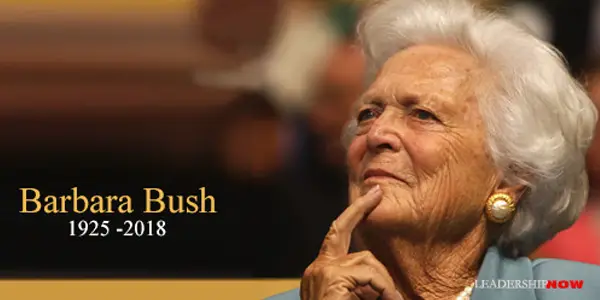
F Born Barbara Pierce on June 8, 1925, in Rye, New York, she was the daughter of a publishing executive and distant cousin of President Franklin Pierce. She has been called the “Matriarch of a Dynasty.” As the wife of the 41st president and the mother of the 43rd, George W. Bush, she was one of two women in American history to have a son of hers follow his father to the White House. The first was Abigail Adams, wife of John Adams and mother of John Quincy Adams. The Bushes had celebrated their 73rd wedding anniversary in January, making them the longest-married couple in presidential history. She was a valuable ally in her husband’s political career. Her son George W. Bush wrote in 41: A Portrait of My Father, “One thing was for sure, Barbara Bush was willing to speak her mind.” During her husband’s 1992 reelection campaign she told the Los Angeles Times, “Some people share in their husband’s work and some don’t. That’s going to depend upon the marriage or their wife’s work. But you have to have influence. When you’ve been married 47 years, if you don’t have any influence, then I really think you’re in deep trouble.” She worked relentlessly for family literacy. “You know sit with your arm around a little kid and read. It not only teaches them to read but it keeps the family strong.” She believed, “Everything I worry about would be better if more people could read, write and comprehend.” Here is a selection of her thoughts on life: “I think togetherness is a very important ingredient to family life.” “Never lose sight of the fact that the most important yardstick of your success will be how you treat other people - your family, friends, and coworkers, and even strangers you meet along the way.” “Your success as a family... our success as a nation... depends not on what happens inside the White House, but on what happens inside your house.” "George Bush has given me the world. He is the best -- thoughtful and loving." “If human beings are perceived as potentials rather than problems, as possessing strengths instead of weaknesses, as unlimited rather that dull and unresponsive, then they thrive and grow to their capabilities.” “You may think the president is all powerful, but he is not. He needs a lot of guidance from the Lord.” She told those gathered at Wellesley College for her June 1990 commencement address: I hope that many of you will consider making three very special choices. She concluded her 1994 memoir with: George Bush and I have been the two luckiest people in the world, and when all the dust is settled and all the crowds are gone, the things that matter are faith, family, and friends. We have been inordinately blessed, and we know that.
Posted by Michael McKinney at 08:41 PM
04.11.18

Don’t Leave Workplace Civility to Chance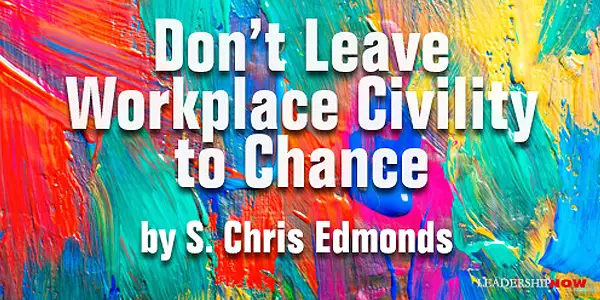
W Our own observations make us keenly aware of these dynamics. Now there is research to - unfortunately - support our observations. A 2017 survey of Civility in America (an annual study undertaken by Weber Shandwick, Powell Tate, and KRC Research - found that 69% of respondents believe the United States has a major civility problem. 75% of respondents believe that incivility has risen to crisis levels. 73% feel that the US is losing stature as a civil nation. There were few optimists among those interviewed. Only 22% of respondents believe civility in America will improve in the years to come. Three additional studies underscore the lack of respect and civility in our workplaces. Gallup’s employee engagement data (Employee Engagement | Gallup Topic) reveals that only 35% of US workers are actively engaged at work. Globally, the number of actively engaged employees is 15%. TINYpulse’s 2017 culture and engagement report found only 26% of employees feel strongly valued at work. The Workplace Bullying Institute’s 2017 study (WBI 2017 U.S. Workplace Bullying Survey | Workplace Bullying Institute) found that 19% of American workers have experienced bullying in the workplace while another19% have witnessed workplace bullying. 61% of Americans are aware of workplace bullying in their organizations. This research and our own experiences make on thing clear: treating colleagues in the workplace with dignity and respect is not the norm. Disrespect and incivility erode trust, performance, service, and proactive problem solving in our organizations every day. All is not lost. I work with senior leaders of organizations of all sizes and industries to help them create purposeful, positive, productive work cultures. Three steps are required to evolve your work culture. They are:
Define your desired work culture. Senior leaders must make values as important as results - and to apply the same discipline to formalizing values expectations and measuring values expectations as they do to formalizing and measuring performance expectations. Values must be shifted from lofty ideals to observable, tangible, and measurable behaviors. By defining company values in behavior terms, those valued behaviors becomes measurable expectations. Let’s take “respect” as an example. One of my recent culture clients defined their respect value - one of six values they formalized - as “appreciating the worth of others and treating everyone with courtesy and kindness.” That’s a great definition, but it’s not in an observable form quite yet. They defined the exact behaviors required with these three valued behaviors:
These behaviors - along with the valued behaviors from their other five values - make it clear what the minimum standards of citizenship are in this organization. Their “values clarity” efforts are complete, but they’re not done with embedding these behaviors. Align all plans, decisions, and actions to your valued behaviors. Senior leaders must model and demonstrate these valued behaviors in every interaction. Simply defining these valued behaviors - and marketing them like crazy with, for example, posters throughout your workspace - does nothing more than increase awareness. The only way to build credibility and inspire everyone in the company to actually demonstrate these valued behaviors every day is for senior leaders - and all leaders in the organisation - to model them in every interaction. Every day. This isn’t easy - but it’s required. The scrutiny is severe. The standards of interaction quality between senior leaders and everyone they interact with vastly increase. Building credibility will take time - 4-5 months or more. During this timeframe, senior leaders must not only model those valued behaviors, they must now coach those valued behaviors, praise aligned behaviors, redirect misaligned behaviors, etc., for the rest of their lives (!). Aligning all plans, decisions, and actions to your valued behaviors becomes a never-ending project. This coaching, praising, redirecting, etc. is the foundation of holding others accountable for those valued behaviors. These same practices are an excellent foundation for holding others accountable for performance expectations, too. A vital part of the align phase is creating a custom values survey, taken by all employees every six months. This survey becomes your “values dashboard,” a way to regularly measure the degree to which leaders are seen by employees as modeling the team or company’s valued behaviors. With every run of your custom values survey, individual leaders - from senior leaders to front-line team leads - receive a profile that indicates their employees’ ratings of their demonstration of each valued behavior. Leaders are praised for aligned behaviors and coached on mis-aligned behaviors. Note that some of my clients are doing pulse values surveys with one question of every employee asked each week rather than three dozen questions asked every six months. This provides a valuable ongoing measurement of values alignment across your leaders. Only when leaders are held accountable for valued behaviors will those behaviors become a foundation of your healthy work culture. Refine valued behaviors every two years or so, as needed. The refine step is simply taking the time every two years or so to update your valued behaviors as needed. Some valued behaviors may be so ingrained you don’t need to keep them on your values list anymore. Some new valued behaviors might need to be added to address new temptations, new generations, new customer or market demands, etc. Your valued behaviors need to evolve as your culture evolves. These three steps work well in departments, small businesses, huge multi-nationals, and every size and type of organization in between. The impact is powerful. When my culture clients implement these three rules, three outcomes consistently emerge. Employee engagement goes up by 40%. Customer service rankings rise by 40%. And results and profits increase by 35% - all within 18 months of implementing this proven process. Don’t leave the quality of your work culture to chance. Make civility and respect a hallmark of every daily workplace interaction - by changing the rules, living the rules, and holding people accountable for the rules. Watch my three minute “Culture Leadership Charge” video on YouTube for further insights. 
Posted by Michael McKinney at 08:50 PM
04.05.18

The Essentials of Theory U
W Part of the problem is the way we approach what we “know” and do. We need a new way of seeing, learning, and doing. This is what Otto Scharmer hopes to do with Theory U. With Theory U, Otto Scharmer has taken well-known ideas and combined them in a profound way. He asks, “How do we learn from the future as it emerges?” In The Essentials of Theory U, Scharmer takes the ideas first presented in Theory U over ten years ago, and made them more accessible. Theory U begins with our blind spot. We see the world the way we are. We create the world we live in. Action comes into the world from what is going on inside of us. Scharmer says, “I pay attention this way, therefore it emerges that way.” So we begin to understand Theory U with the blind spot. Too often we don’t factor in our interior condition. “We can see what we do (results). We can see how we do it (process). But we usually are not aware of the who: the inner place or source from which we operate.” That is our blind spot: the place from which our attention and our intentions originate—our source. The question for leaders is “How does our blind spot show up in our leadership?” What I give attention to, what I notice, what I act on, is a function of my interior condition. This of course, affects how and what we learn and thus what we can apply to any given situation. Typically, we learn from the experiences of the past, but because or most issues, responding with what we have learned is not going to be enough, Scharmer suggests that we work to learn from the future as it emerges. He calls this presencing. We can engage in the moment in two ways. One is the present moment that “is basically and extension of the past. The present moment is shaped by what has been. The second is a quality of the present moment that functions as a gateway to a field of future possibilities. The present moment is shaped by what is wanting to emerge. That quality of time, if connected to, operates from [pre-sensing] the highest future potential.” In times like ours, it is this second presencing quality of the present that matters most because “without that connection we tend to end up as victims rather than co-shapers of disruption.” How can we begin to presence as individuals, organizations, and as a society? Theory U is a way of making a system (or an individual) sense and see itself. The core process can be seen in the diagram below. Looking at the bottom “U” Scharmer describes each of the seven ways of attending to and co-shaping the world: Downloading is business as usual. Repeating the same old patterns of thought. In this state, “the world is frozen by our old mental habits and past experiences; nothing new enters our minds. Seeing is when we suspend our habitual judgment and wake up with fresh eyes. As we suspend we have to tolerate that nothing is happening. Staying with it is the key. Sensing is the “moment we redirect our attention from objects to source.” Our perceptions widen and deepen. “The boundary between observer and observed opens up.” We begin to see the from a perspective that includes ourselves. The system begins to see itself. Presencing is when we let go of the old and connect to the surrounding sphere of future potential. “The boundary between observer and observed collapses into a space for the future to emerge.” We are connecting to the deepest source—the interior condition from which we operate. Our purpose. Seeing from the whole. We must be willing to drop everything that is not essential. “Crossing the threshold means to be willing to let go. TO let go of old patterns, assumptions, and even our old ‘ego-self.’ Only then is it possible to step into our dormant potential, our emerging ‘Self.’” Crystallizing is when we begin to envision the future that seeks to emerge from a deep connection to the source. “Envisioning happens from the field of the future (rather than from our ego). Prototyping is exploring the future by doing. Bringing the new into reality by improvising and linking the intelligence of the head, heart, and hands. Performing by embodying the new from the context of the larger eco-system—the whole. Embedding the new through new practices, processes, and infrastructures while maintaining a connection to the source. The inverted view on the top of the chart is about destruction rather than creation. It is the result of closed will, heart and mind—fear, hate, and prejudice. Rather than experiencing presencing after downloading, we begin to deny or silence other views out of prejudice, we entrench, manipulate, bully and eventually destroy. Scharmer says “leadership is the capacity to shift the inner place from which we operate.” So that the primary job of leadership is to help people discover the power of seeing and seeing together. Theory U is about change. When you as a change maker begin to see what you didn’t see before and at the same time, see your own part in maintaining and defending to past patterns and thinking, real change can begin to occur. “The key leverage point for transformational change starts with attending to how you as a change maker relate to the system that you want to change and to the system that you want to give birth to.” For Scharmer, understanding change, boils down to this: “The quality of results achieved by any system is a function of the quality of awareness that people in these systems operate from. In three words: Form follows consciousness.” 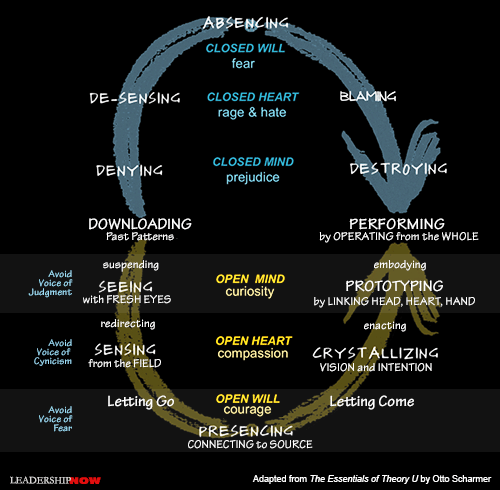 
Posted by Michael McKinney at 07:39 AM
04.03.18

Servant Leadership in Action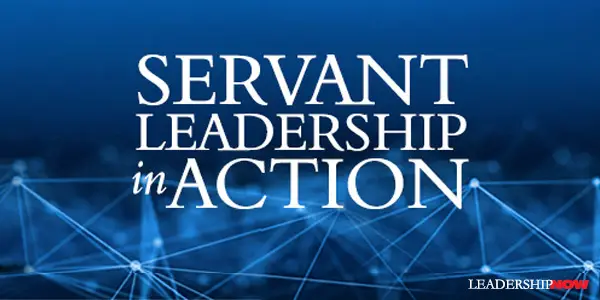
T Ken Blanchard begins by telling us that some people think you can’t lead and serve at the same time. But that is because they don’t understand that there are two parts to servant leadership: a visionary/direction, or strategic role—the leadership aspect of servant leadership and an implementation, or operational role—the servant aspect of servant leadership. “The leadership aspect of servant leadership is the responsibility of the traditional hierarchy. The servant aspect of servant leadership is all about turning the hierarchy upside down and helping everyone throughout the organization develop great relationships, get great results, and, eventually, delight their customers.” Raj Sisodia is a leader in the Conscious Capitalism movement and relates servant leadership to the acronym, SELFLESS: Strength, Enthusiasm, Love, Flexibility, Long-Term Orientation, Emotional Intelligence, Systems intelligence, and Spiritual Intelligence. He explains, “The servant leader is a whole person, not a fragmented being. SELFLESS reflects a harmonious blend of mature masculine and mature feminine qualities.” Steven R. Covey says that trust is essential. “Both servant leadership and trust-based leadership stand in opposition to traditional positional leadership, which is steeped in the language of control: ‘You have to do what I say because I’m the boss.’ On the other hand, servant leaders and trust-based leaders alike draw from a deeper well of meaning. They serve first and they extend trust first. Leadership is the by-product and positional authority is, at best, an afterthought.” Mark Floyd admits, “Servant leaders are not always perfect, but they stay true to their leadership style. They stay humble by turning the organizational chart upside down and serving others. They communicate to their teams the goals and values that form their culture so that everyone stays in focus. They are aware of their own strengths and weaknesses—through feedback and by following the greatest servant leader of all time [—Jesus]. And they continually strive to do the right thing.” Simon Sinek adds, “The daily practice of servant leadership is less grand than people tend to think. It is not based on a series of transactions, but on the promise of being there when someone needs you most. … A leader who offers money or the potential for future riches is not earning loyalty. They are setting up a transactional relationship that is likely to promote self-interest. … A few scattered, well-intentioned actions by a leader can’t hurt, but they won’t breed loyalty. They won’t be enough to earn trust. Just like any relationship in which trust is the basis, it is the combination of a lot of little things that makes all the difference.” To avoid the triggers that would pull you off course, Marshall Goldsmith recommends that the next time you run into a conflict, ask yourself this question: “Am I willing, at this time, to make the investment required to make a positive difference on this topic?” Erwin McManus illustrates that servant leadership is not a technique but a way of being. After his wife watched him perform a reluctant act of service for a homeless man in a downpour, she said, “That was the greatest sermon you have ever preached.” Those words changed his life. He writes, “Frankly, I had always hoped my greatest message would be to an audience of thousands, not to an audience of one. Now I know better. Our message is always given to an audience of one—the person we are serving. In serving others, our message is our lives. We must live our message for our message to have life. To me, that’s what servant leadership is all about.” To McManus' point, Jon Gordon adds in his essay, “My company’s mission is to inspire and empower as many people as possible, one person at a time. One person at a time means we will never be too busy to help one person in need.” In other essays by Brené Brown, Cheryl Bachelder, Henry Cloud, Jon Gordon, James Kouzes, Patrick Lencioni, Dave Ramsey, Art Barter, Larry Spears, and many others, you will find many more helpful ideas and thoughts that will help you shape and refine your leadership approach.  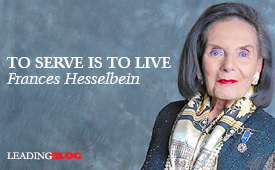 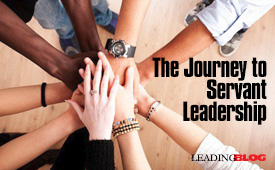
Posted by Michael McKinney at 02:08 PM
04.01.18

First Look: Leadership Books for April 2018Here's a look at some of the best leadership books to be released in April 2018. Don't miss out on other great new and future releases this year.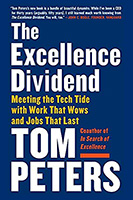 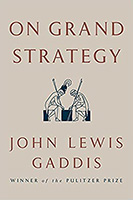 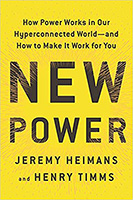 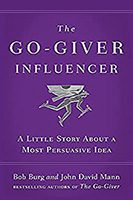 
For bulk orders call 1-800-423-8273  Build your leadership library with these specials on over 39 titles. All titles are at least 40% off the list price and are available only in limited quantities. "We read to know we are not alone." — C.S. Lewis
Posted by Michael McKinney at 01:07 PM
|
BUILD YOUR KNOWLEDGE


How to Do Your Start-Up Right STRAIGHT TALK FOR START-UPS 
Grow Your Leadership Skills NEW AND UPCOMING LEADERSHIP BOOKS 
Leadership Minute BITE-SIZE CONCEPTS YOU CAN CHEW ON 
Classic Leadership Books BOOKS TO READ BEFORE YOU LEAD |
|